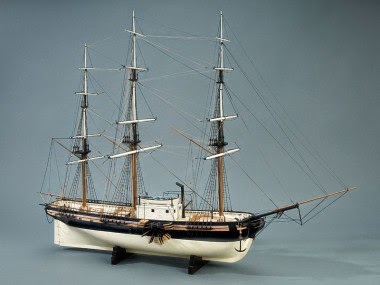Today we return to Colonial Cemetery in Savannah, Georgia to visit another famous resident of the city. William Scarbrough was born in 1776 and died in 1838. William Scarbrough was the driving force behind the Savannah Steam Ship Company. The SS Savannah was built by Fickett and Crocker in New York in 1818 as a hybrid sailing ship. New London sea captain Moses Rogers convinced the shipping firm of Scarborough & Isaacs to purchase the ship and convert it to steam power and sail it across the Atlantic. Moses Rogers oversaw the installation of the ships steam engine. The ship was launched on August 22, 1818 and took her maiden voyage on March 28, 1819. This is a model of the ship as it originally appeared.
William Scarbrough had a home in Savannah designed by the famous architect William Jay. The home hosted President James Monroe who visited Savannah at the invitation of William Scarbrough to cruise on the Savannah before her transatlantic voyage. On May 11, 1819 President Monroe arrived in Savannah to take an excursion on the ship. The Savannah departed at 8 a.m. under steam headed for the Tybee Lighthouse. They arrived at 10:30 a.m. and departed again at 11:00 a.m. The President dined onboard and was enthusiastic about the ship making the world's first transatlantic crossing under steam power. The Savannah was scheduled to leave on May 20, 1819 and an newspaper ad appeared attempting to secure passengers and freight. The departure was delayed after one of the crew returned to the ship in a highly inebriated state, fell off the gangplank and drowned. The delay gave everyone time to reconsider but no passengers or freight came forward so the voyage was purely experimental. They set sail on May 24, 1819 under steam. Later in the day the paddlewheels were stowed for the first time and the ship proceeded under sail. On June 19th off the coast of Ireland the Savannah encountered the HMS Kite. The crew of the Kite saw the smoke and assumed the Savannah was on fire. They followed the ship for several hours but were unable to catch up so they fired several warning shots and Captain Rogers brought the Savannah to a stop. The Kite caught up and its commander requested and was granted permission to inspect the ship. The Savannah landed at Liverpool on June 20th and took on fuel and supplies. They remained at Liverpool for 25 days before departing for St. Petersburg, Russia. They reached Elsinore, Denmark on August 9th and were quarantined for 5 days. On August 14th the ship sailed to Stockholm, Sweden becoming the first steamship to enter the Baltic Sea. The Savannah arrived in Stockholm on August 22nd and departed on September 5th bound for Kronstadt, Russia. They arrived in St. Petersburg on September 13th and departed for the return trip to America on September 29th. She arrived back in Savannah on November 30th for a total of 6 months and 8 days since her departure. In January 1820 a fire swept through the business district in Savannah doing severe damage and Scarborough and Isaacs losses caused them to have to sell the ship. The steam engine was removed and sold. The ship was used as a sailing packet operating between New York and Savannah until running aground at Long Island on November 5, 1821 and breaking up. The Savannah had proved a steamship could cross the ocean but the public was not prepared to trust it and the large space taken up by the engine and fuel made the ship uneconomic. It would be 20 years before steamships began making regular crossing of the Atlantic and 30 years before another American owned steamship would do so. That is not the end of the story of William Scarbrough.
Earlier mention was made of the Scarbrough house. This is a picture of it as it appears today. In addition to the loss of the SS Savannah due to the fire of 1820 the financial losses suffer by William Scarbrough forced him to sell his house. The home eventually became property of the Diocese of Savannah to be used by the Sisters of Saint Joesph as a boys orphanage. It was used as such from 1870 to 1876. In 1878 the house was purchased by the city of Savannah and became the first public school in Savannah and one of the first in the south or the education of African American children. The school was closed in 1962 and the house fell into disrepair. In 1972 the Historic Savannah Foundation began a million dollar plus restortation. In 1995 the Ships of the Sea Maritime Museum acquired the house and restoration was completed in 1997. The Museum is open to the public and contains many ship models including the one pictured earlier in this post. It is an excellent example of Greek Revival architecture and is located at 41 Martin Luther King, Jr. Boulevard.
William Scarbrough, another man with a vision who still has an impact on Savannah today.



No comments:
Post a Comment